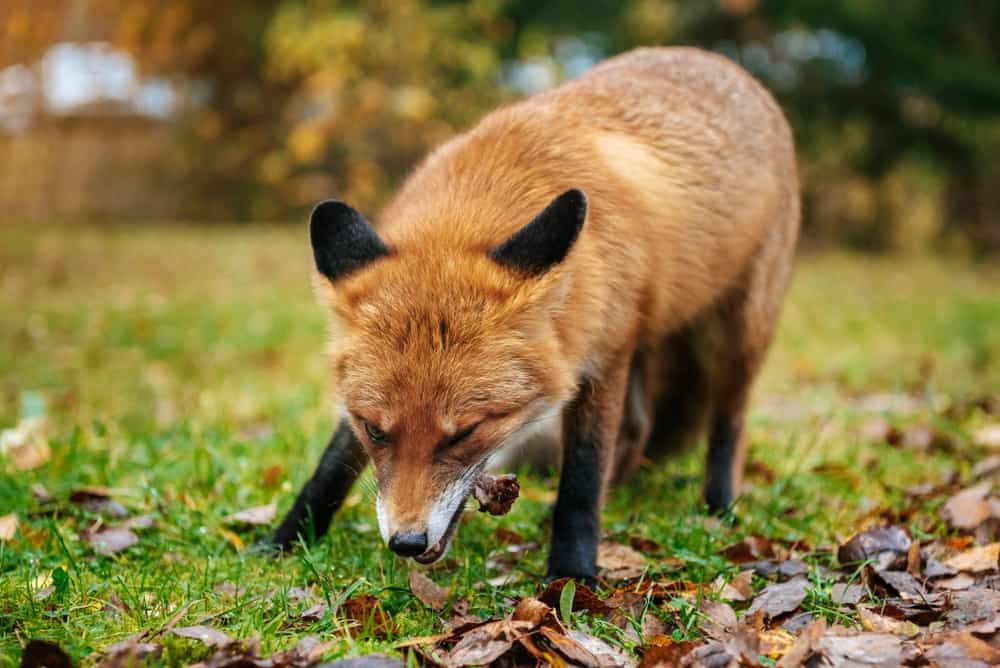Want to learn more about kit foxes? You’ve come to the right place. Not only are we going to cover what kit foxes eat, but we’ll also take a look at other kit fox facts.
Kit foxes, which go by the scientific name Vulpes macrotis, are found in arid regions in the southwestern part of North America. Kit foxes are the smallest members of “Vulpes”, or true foxes, found in North America and enjoy a varied diet. Let’s dig in.
Kit Foxes Habits and Biology
Kit foxes are the smallest of the foxes found in North America, typically weighing between 1.6 and 6 pounds. These foxes typically measure from about 18 to 21 inches in length (not including their tail). Kit foxes are easily recognizable due to their large ears, which may stand more than 3.5 inches tall.
When you think of foxes, you might think of reddish-brown foxes with a whitetail. A kit fox’s fur will often vary based on habitat, and may also change with the seasons. That said, tan and yellowish-gray coats are common during the summer months. Come winter, many kit foxes sport a silvery gray fur coat.
Now let’s take a look at a couple of kit fox fun facts!
- The kit fox’s large ears are great for hearing but they serve another important purpose. The ears’ large surface area allows them to release heat, which is important given that kit foxes often live in hot deserts.
- Kit foxes have taken up home in human habitats, including suburbs and cities, and help control local rodent populations. Human settlements attract a lot of rodents, which can spread diseases. Fortunately, kit foxes, cats, and other animals help keep rodent populations under control.
- Kit foxes often enjoy strong family ties. Older children may stay with their mom and dad and help raise younger kit fox pups (which are sometimes called kits). Parents are often happy for the assistance and can help their older children improve their hunting skills.
Kit foxes sometimes live in groups, which often consist of family members. However, kit foxes normally hunt alone. That said, younger foxes will hunt with their parents to improve their hunting skills.
Kit foxes typically live in arid, often hot regions. Owing to heat and the harsh desert sun, kit foxes are often nocturnal, hunting only a night. During the day, kit foxes often hide in cool dens.
Kit foxes also don’t need to drink water. They can typically get all the water they need from their diet, which includes insects, rodents, and some fruits and berries (which often contain a lot of water).
What Do Kit Foxes Like to Eat Most?
What do kit foxes eat? Kit foxes are omnivores like us humans.
Many carnivores, or “meat-eaters,” struggle to digest plant matter. Meanwhile, many herbivores, or plant eaters, cannot easily digest meat. Omnivores, including kit foxes and humans, can digest both meat and plants.
Kit foxes are also scavengers, and in practice, they aren’t too picky about what they eat. They are “opportunistic eaters,” meaning they’ll often eat what’s in front of them. Some animals will only leaves from a small number of plants or specialize in hunting a limited range of animals. Not kit foxes.
While kit foxes are omnivores, most prefer to eat meat. Perhaps you have favorite foods you enjoy, such as apples or hamburgers. Kit foxes primarily eat small animals and insects, including but not limited to rabbits, small lizards, and birds.
Kit foxes are pretty small and they typically prey on small animals. They’ll rarely hunt anything larger than the common Black-tailed jackrabbit, which typically weighs no more than six pounds. While Black-tailed jackrabbits are often larger than the rabbits you’ll find at a pet store, they aren’t particularly big.
- As for plants, kit foxes generally prefer fruits. They may eat tomatoes (which are technically fruit), cactus fruits, berries, and other fruits too.
- Cactus fruits seem to be a favorite, although that may be due to availability rather than taste. Since these foxes prefer dry environments, cacti are often among the most common plants in their ecosystem.
- Most kit foxes use plants to supplement their diets and seem to prefer eating small prey. When it comes to prey, kit foxes prefer rodents, including rats, prairie dogs, mice, and rabbits.
- Kit foxes may also eat small birds, snakes, lizards, and insects. Many of these animals are commonly found in the deserts and other areas kit foxes inhabit.
- In captivity, kit foxes can be fed wet cat food and dog food.
Food to Avoid Feeding Kit Foxes
As scavengers and opportunistic feeders, kit foxes will often eat just about anything put in front of them. However, some foods may poison foxes. Unfortunately, some animals don’t know what’s good for them, and kit foxes may eat toxic foods if you offer it to them.
That’s why it’s important for anyone feeding kit foxes to be careful. Let’s take a look at some foods you should NOT feed to these foxes.
Avocados have become very popular in recent years. However, you should not feed avocados to foxes. Why? Avocados contain a toxin called persin, which can be found in the fruit, leaves, and bark of the avocado plant.
Caffeine is another danger for foxes and dogs too. Kit foxes and many other animals have a low tolerance for caffeine and even small amounts could make an animal sick. In a worst-case scenario, the fox might die. Caffeine is found in many things, including soda and chocolate.
Chocolate also contains a substance called theobromine, which is poisonous to many animals. Darker chocolate often contains more theobromine, making it even more dangerous. Between caffeine and theobromine, chocolate is dangerous for many animals including but not limited to kit foxes.
Kit foxes in nature often eat tomatoes. However, tomatoes, peppers, and green eggplant contain glycoalkaloids, which are toxic for foxes.
Red, ripe tomatoes often don’t contain high levels of glycoalkaloids. Still, the green fruits, stems, and leaves of tomato plants, among other plants, may contain glycoalkaloids.
Hopefully, kit foxes in the wild know not to eat plant matter containing glycoalkaloids. Anyone feeding or keeping kit foxes should be mindful. Green potatoes may also contain glycoalkaloids and other dangerous chemicals and are best kept away from kit foxes.
You might enjoy onions on your food. However, when it comes to foxes, you should avoid feeding them anything from the onion family, including garlic and chives. These plants contain sulfur compounds that can irritate foxes and some other animals.
Finally, some baked goods, gum, and toothpaste contain a chemical called Xylitol. This chemical can cause liver problems in dogs and perhaps foxes too. It’s best to keep Xylitol and anything that might contain it away from kit foxes.
Tips for Feeding Kit Foxes
If you’re feeding kit foxes, make sure you pay close attention to the above “do not feed” foods. Even a small bit of chocolate, for example, could make a kit fox sick. Kit foxes in nature enjoy varied diets. It’s wise to offer kit foxes in captivity a similarly varied diet.
Kitfox newborns and kits (fox pups are often called kits) are especially hard to feed. Whenever possible, it’s best to let kits feed from their mothers for as long as possible.
If a kit fox cannot feed off its mother for whatever reason, you should use puppy milk replacement formula, not common cow’s milk (which may make the kits sick). Goat milk may also work.
Using a small syringe (e.g 4 milliliters), you should lay the kit on its belly, which is its natural feeding position. It’s best not to cradle kits during feeding.
The kit should latch into the syringe if you put it in front of them. Then, slowly squeeze out drops of formula. Kits should be fed every three hours. Kits may also need help going to the bathroom. Pet caretakers often wet a cloth and wipe the kit’s genital areas to encourage them to go to the bathroom.
At around 4 weeks, kits can start eating solid foods. Canned kitten or puppy food is a smart choice. Adding some raw chicken, beef, and other meats to their diet is also wise.
As for fruits and veggies, sliced apples, bananas, pears, various berries, green peas, and diced carrots are good choices.
As for feeding adults, kit foxes should be fed three times per day. Occasional treats between mealtime are also appropriate.
Canned dog/cat food plus raw chicken, deer, and rabbit are also wise. When it comes to snacks, you should give your kit foxes a few boiled eggs each week. Sliced apples, berries, and pears make for good snacks too but an adult kit fox’s diet should include mostly meat protein, including raw meats.
While kit foxes do not need to drink water in nature, you should still provide a water bowl for kit foxes in captivity.
Kit Foxes FAQs
1. When are kit foxes most active?
In nature, kit foxes are typically most active at night. This allows them to avoid the hot desert sun. In captivity, many kit foxes are still nocturnal.
2. Can I give a kit fox water?
Wild kit foxes can get most if not all of their water from their diet. Still, kit foxes will drink water when available. Giving kit foxes appropriate amounts of water is usually fine.
3. How can kit foxes move across hot sand and ground?
Hot sand at the beach can be uncomfortable for people to walk on. How about kit foxes? They have padded paws with tufts of hair that allow them to walk on hot surfaces without much trouble.
4. Can I feed kit foxes human food?
Generally speaking, kit foxes should not eat processed human foods, which may contain a lot of salt, caffeine, and other things that can make foxes sick. You shouldn’t feed kit foxes human foods, and especially chocolate.
5. Can I feed kit foxes a vegetarian diet?
Kit foxes are omnivorous and will enjoy eating certain fruits and vegetables. That said, kit foxes need the protein and other things found in meat. As such, they should be fed meat regularly, including canned dog food and raw chicken.
6. Can I feed kit foxes tomatoes?
In the wild, kit foxes will eat tomatoes. In captivity, it’s best to avoid tomatoes as they sometimes contain substances that are dangerous to foxes.
7. Can I give kit foxes milk?
Many humans drink cow milk. However, many animals are lactose intolerant, meaning they can’t drink cow’s milk. It’s usually best to avoid giving foxes cow’s milk. However, puppy replacement formula and goat milk are usually appropriate for foxes.
8. Do kit foxes make good pets?
Cats and dogs are domesticated, meaning they’re used to living around people. Kit foxes, on the other hand, are not domesticated and are wild animals. It’s usually best to let them live in nature. While foxes may occasionally make great pets, they are often hard to take care of and may not enjoy living with people.
Kit Fox Summary
As you can see, kit foxes are very interesting animals. If you or someone you know is taking care of kit foxes, make sure you provide them proper care, including healthy, nutritious foods. Kit foxes have their own unique diet and needs. Anyone taking care of kit foxes must understand their unique needs and diet.




